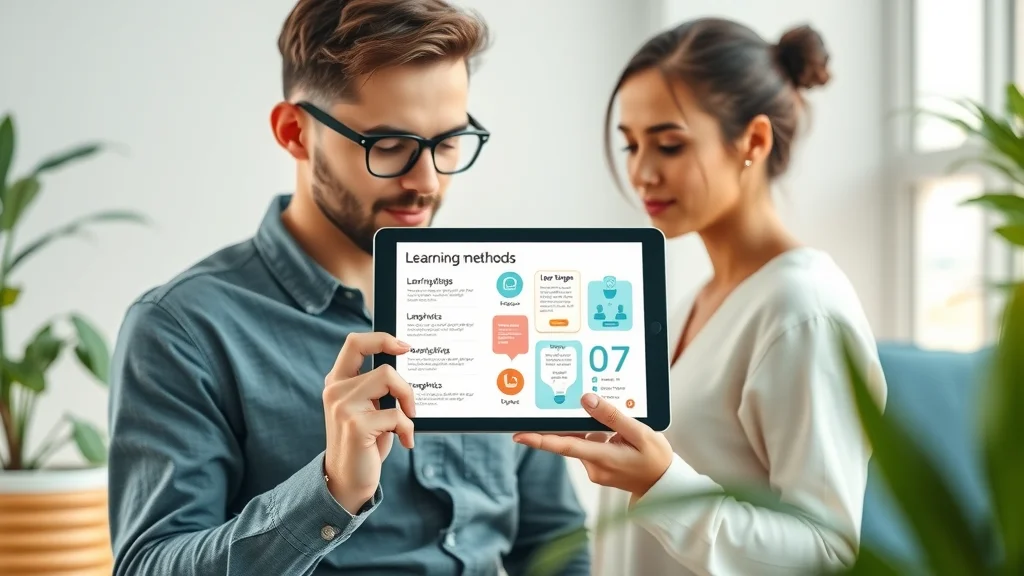Did you know that e-learning can help learners retain up to 60% more information compared to traditional classroom methods? In today’s fast-paced world, digital education isn’t just reshaping how we learn—it’s establishing new benchmarks for efficiency, accessibility, and personalized achievement in both education and professional growth. Whether you’re an educator, a business leader, or a lifelong learner, this guide explores why e-learning is the essential learning method for the 21st century.
E-learning at a Glance: A Modern Learning Method
E-learning has revolutionized how we approach learning and upskilling, bridging gaps that once made education inaccessible for many. This modern learning method enables people to access rich educational content and online courses at their own pace, using digital devices anywhere and at any time. The explosion of innovative learning platforms and authoring tools means instructional design is now more interactive, visually engaging, and relevant than ever—empowering students and professionals alike.
What sets e-learning apart is its unique ability to save time and boost productivity. Instead of adhering to rigid classroom schedules, learners can tailor their experience to suit their lifestyles. The rise of online training programs and virtual classrooms allows organizations to rapidly upskill their workforce, deliver compliance training, and meet evolving learning needs on a global scale. By combining flexibility with powerful analytics and engaging content, e-learning is fast becoming the preferred choice for effective education and professional development.

Opening Insights: Surprising Facts About E-learning
Few realize that e-learning has grown over 900% globally since the early 2000s, driven by rapid technological advancements and the demand for flexible, high-quality education. According to recent studies, companies adopting e-learning platforms report a 42% increase in revenue per employee and a significant drop in training costs. It’s no surprise, then, that e-learning is quickly overtaking traditional learning methods for compliance training, professional certification, and skills upgrades worldwide.
Beyond cost and efficiency, e-learning platforms harness multimedia learning content and artificial intelligence to address unique learning preferences and needs. Every learner—visual, auditory, or kinesthetic—can now engage with personalized educational content through interactive simulations, real-world scenarios, and self-paced online courses. These evolving learning experiences not only improve knowledge retention but also foster a proactive, growth-driven mindset in both students and working professionals.
What You'll Learn in This Guide to E-learning
- The fundamental concepts and benefits of e-learning
- How e-learning platforms work and their distinguishing features
- Various learning methods and content types within e-learning
- The impact of e-learning on time savings, accessibility, and compliance training
- Best practices for instructional design in digital education
- Key considerations for selecting e-learning solutions
What is E-learning? Defining the Essential Learning Platform
E-learning is the use of electronic technologies to deliver educational content, training materials, and learning experiences via digital devices and networks—most commonly through dedicated online learning platforms. At its core, e-learning shifts learning from static textbooks and physical classrooms to dynamic, multimedia environments accessible anywhere. This transition enables users to engage with interactive courses, video lectures, simulations, quizzes, and more, tailoring their learning path to specific needs and interests.
The defining strength of an e-learning platform is its ability to centralize and customize both educational content and user progress. Whether using a robust learning management system, mobile-compatible software application, or open source authoring tool, e-learning provides measurable outcomes. Educators and businesses can monitor completion rates, adjust instructional design strategies, and offer real-time feedback—transforming the way individuals and learning teams grow their knowledge and skills in today’s digital world.

A Comprehensive Definition of E-learning
At its most comprehensive, e-learning (also known as online learning or electronic learning) refers to learning delivered or facilitated through digital resources and electronic devices. This includes online courses, web-based training programs, and self-directed learning modules accessed via computers, tablets, or smartphones. E-learning systems can range from simple video-based lessons to immersive, interactive management systems that support a blend of multimedia, quizzes, virtual classrooms, and simulation exercises.
The characteristics that define e-learning include on-demand access, scalable delivery, and data-driven tracking. Unlike traditional classroom setups, e-learning platforms empower both individuals and organizations to keep pace with industry requirements, compliance training, and evolving learner expectations. With powerful authoring tools and instructional design frameworks, e-learning content creators can design flexible, engaging, and measurable educational experiences for diverse audiences worldwide.
The Evolution: From Classroom to E-learning Platforms
The journey from classroom chalkboards to comprehensive learning platforms marks a fundamental shift in the way education is delivered and experienced. Traditional learning methods relied on physical presence, fixed schedules, and a one-size-fits-all approach—a model that increasingly struggled to meet the needs of today’s dynamic workforce and global student body.
E-learning platforms emerged as digital solutions capable of overcoming these limitations. Online courses suddenly made expert-led lectures and training programs accessible to anyone with an internet connection, from remote villages to urban hubs. Learning management systems became the backbone of continuous education, facilitating seamless content updates, analytics tracking, and adaptive learning paths. Today’s blend of multimedia content, instant feedback, and collaborative online environments truly sets e-learning apart as the next evolution in accessible, personalized education.

Key Advantages of E-learning: How It Saves Time and Boosts Productivity
E-learning’s rise isn’t just a trend; it’s driven by measurable advantages that matter to learners, educators, and businesses. Chief among these is its proven ability to save time—employees, students, and professionals can complete online courses at their own pace, often finishing training modules in a fraction of the time required for face-to-face sessions. With no need for travel or costly printed materials, organizations further benefit from significant reductions in overhead and environmental impact.
Additionally, e-learning offers unparalleled scalability and adaptability. Training programs can be rolled out to global teams simultaneously, with digital analytics capturing engagement and progress instantly. Interactive learning content, from video explainers to branching scenario simulations, keeps learners engaged while ensuring retention. As demands for compliance training, skills upgrades, and professional certification grow, e-learning’s time-saving, flexible methods will remain central to future-proof education strategies.
Flexibility and Accessibility in E-learning
One of the standout benefits of e-learning is the remarkable flexibility it offers across all learning methods. Learners are no longer bound by location or strict schedules, as online training programs provide access to essential learning content from any device and setting. This level of accessibility is especially valuable for students balancing work, family commitments, or time zone differences, as well as for organizations training distributed or global teams. By adapting to diverse lifestyles and learning preferences, e-learning platforms ensure that everyone can participate—no matter their background or schedule.
Accessibility is further enhanced through mobile compatibility and multi-language support, important features for reaching a truly global audience. E-learning elevates inclusivity, helping learners with disabilities via screen readers, captioned multimedia content, and customizable user interfaces. This democratization of education is one reason why online learning continues to gain ground as an essential component of lifelong personal and professional development.

How E-learning Saves Time Compared to Traditional Learning Methods
Time savings are perhaps the most compelling advantage of e-learning. Digital learning platforms allow information to be absorbed at the learner’s optimal pace—fast for those who grasp concepts readily, or with pauses and rewinds for those needing extra review. This personalized pacing eliminates the downtime of group instruction and reduces delays associated with coordinating in-person events. Additionally, employees can integrate online learning sessions directly into their day, increasing productivity while honing essential skills on demand.
For organizations, e-learning’s asynchronous nature means compliance training, onboarding, and ongoing professional development no longer interrupt routine work. Recent research indicates that companies adopting comprehensive e-learning solutions complete training up to 60% faster without sacrificing quality. Automated progress tracking and instant assessment feedback streamline knowledge verification, making instruction more targeted and efficient. In summary, e-learning does not just streamline the delivery of educational content—it transforms how quickly and effectively knowledge is gained and applied.
"E-learning enables learners to access content anytime, anywhere, eliminating geographical and time constraints." – EdTech Expert
E-learning vs. Other Learning Methods: A Comparative Overview
While traditional learning methods and in-person classrooms have their strengths, the rapid evolution of e-learning platforms has fundamentally altered the educational landscape. E-learning’s digital-first approach supports visual, auditory, reading, and kinesthetic learning styles through varied, interactive content. Blended learning, in particular, leverages the strengths of e-learning combined with face-to-face engagement, offering a flexible and robust alternative to singular training methods.
Organizations are seeing tangible advantages by shifting to or supplementing their learning programs with digital courses. The capacity to deliver complex compliance training, update training materials in real-time, and scale instruction without logistical barriers makes e-learning solutions an essential tool for modern learning teams. Comparing and understanding these methods is key to crafting effective, engaging, and sustainable learning experiences for tomorrow’s workforce.
Traditional Learning vs. E-learning: Features and Limitations
Traditional, classroom-based learning is valued for its personal interactions and immediate feedback, which foster a sense of community and engagement. However, these benefits often come at the cost of flexibility—fixed schedules and geographical constraints make it challenging for many learners, especially working adults or those in remote areas, to participate. Updating physical training materials, managing logistics, and accommodating different learning styles can also present significant hurdles for institutions and businesses.
In contrast, e-learning solutions excel in adaptability. Online courses provide on-demand access to learning content, self-assessments, and discussion forums. Learning management systems automate content delivery, assignment tracking, and progress measurement, significantly streamlining administration. While face-to-face elements like nonverbal cues and social interaction may be reduced, advances in video conferencing, interactive forums, and virtual classrooms are narrowing that gap. Ultimately, modern learning platforms are designed to combine the best of both approaches for all types of learners.

Blended Learning: Integrating E-learning with In-person Training
Blended learning is an educational approach that combines online learning solutions with traditional, in-person instruction. This hybrid model offers learners the best of both worlds: the convenience of self-paced, digital learning content and the interpersonal engagement of classroom sessions. In blended learning, students might first complete interactive modules or online courses, then participate in live workshops or group discussions to reinforce and deepen understanding.
This integrated training method allows for more personalized instructional design, enabling educators and businesses to tailor learning experiences to specific needs. For compliance training, for example, employees can first master the basics through e-learning modules before practicing scenarios or taking assessments in a classroom setting. By merging efficient technology with human connection, blended learning increases engagement, retention, and overall satisfaction among learners of all backgrounds.
| Aspect | E-learning | Classroom Learning | Blended Learning |
|---|---|---|---|
| Flexibility | High – Access anytime, anywhere | Low – Fixed times and locations | Moderate – Mix of online and in-person |
| Scalability | Global, instant reach | Limited by size/location | Flexible, adaptable reach |
| Learning Styles | Supports visual, auditory, kinesthetic, reading/writing (VARK) | Mainly auditory/visual | Addresses all styles |
| Cost | Lower per learner, minimal travel/materials | Higher per learner, physical resources needed | Varies, often cost-effective |
| Compliance Training Delivery | Automated, monitored online | Manual, in-person tracking | Automated with hands-on elements |
E-learning Content and Course Types
The effectiveness of an e-learning platform hinges on the diversity and quality of its learning content. Modern online courses blend formats like videos, quizzes, simulations, infographics, and interactive case studies—each designed to meet a wide range of learning styles and objectives. Instructional designers use sophisticated authoring tools to create engaging educational content that encourages active participation, not just passive consumption.
Whether for professional certifications, compliance training, or personal interests, the range of course types available through e-learning solutions is constantly expanding. Organizations benefit from the ability to deploy standardized learning programs across locations, while learners of every age can pursue new skills and knowledge at their preferred pace. The digital format allows content to be updated instantly, ensuring every course remains relevant and effective.
Types of E-learning Content: Multimedia, Interactive, and Simulations
Today’s e-learning content spans far beyond basic lectures or text-based documents. Multimedia elements—such as instructional videos, animations, podcasts, and infographics—enhance engagement and accommodate various learning methods. Interactive modules, scenario-based simulations, and gamified quizzes bring learning material to life, allowing users to test their understanding and receive immediate, personalized feedback.
Simulations, in particular, offer immersive experiences that resemble real-world environments or challenges. For compliance training or technical skills development, these digital simulations help bridge the gap between theoretical knowledge and practical application. Cutting-edge authoring tools and management systems support multimedia-rich course development, allowing e-learning content creators to design robust, effective learning programs tailored to enterprise needs or individual interests.
Online Courses: Self-paced vs. Instructor-led E-learning
Online courses generally fall into two core categories: self-paced and instructor-led. Self-paced learning programs offer the greatest flexibility, enabling users to complete modules, assessments, and projects at their own rhythm—perfect for independent learners or busy professionals. These courses leverage automated feedback and adaptive instructional design to personalize the learning path, making them ideal for scalable training programs or compliance modules.
Instructor-led courses, delivered through virtual classrooms or live video sessions, closely resemble traditional classroom structures but benefit from online reach and instant materials updates. Learners can interact directly with subject-matter experts, participate in group discussions, and receive real-time guidance and support. Many robust e-learning solutions offer hybrid options, combining the autonomy of self-paced modules with the collaborative aspect of instructor-led learning for optimal results.

Learning Programs for Professional and Personal Development
The versatility of e-learning extends across professional upskilling, personal growth, and lifelong learning initiatives. For businesses, structured e-learning programs streamline employee onboarding, compliance training, and ongoing upskilling—delivering consistent, measurable results enterprise-wide. Authoring tools and learning management systems enable learning teams to rapidly update training materials to reflect regulatory changes or emerging skills needs, without interrupting daily operations.
On the personal side, individuals can access a vast array of online learning content tailored to hobbies, languages, certifications, or creative pursuits. This democratization of education removes many barriers faced in traditional settings, such as high costs or limited program availability. As technology evolves, expect to see even richer learning experiences through virtual reality, artificial intelligence-driven recommendations, and immersive interactive modules—placing powerful educational opportunities in the hands of every learner, everywhere.
Choosing the Right E-learning Platform: Features and Selection Criteria
Selecting an effective e-learning platform is crucial for maximizing learning outcomes and ensuring return on investment. The best platforms offer intuitive navigation, customizable course catalogs, seamless integration with compliance requirements, and robust analytics. Essential features like mobile compatibility, user-friendly authoring tools, and comprehensive support for instructional design empower organizations to build adaptable, scalable, and engaging learning courses with minimal technical hurdles.
Businesses should also look for platforms that allow for easy integration with existing management systems and offer responsive customer support. The ability to track learner progress, generate compliance training audits, and analyze educational outcomes is key to continuous improvement. By prioritizing these criteria, both educators and enterprises can find a learning platform tailored to their audience and strategic objectives.
Top Features of Effective E-learning Platforms
- Course variety and customization
- User-friendly interface
- Mobile compatibility
- Analytics and reporting tools
- Integration with compliance training modules
- Support for instructional design best practices
Modern learning platforms stand out by providing diverse course libraries, customizable programs, and open source authoring tools. A strong user interface promotes engagement, while mobile applications support on-the-go learning—essential for today’s distributed and hybrid learning teams. Powerful analytics dashboards help organizations pinpoint which training programs are most effective, ensuring continuous improvement. Integration with compliance management ensures regulatory requirements are met, streamlining both onboarding and ongoing staff training. Finally, best-in-class platforms support authoring tools and instructional design standards, empowering organizations to build rich, measurable learning experiences tailored to evolving business needs.

Leading E-learning Solutions for Businesses and Educators
The market offers a wide range of solutions, from large enterprise learning management systems to agile, open source software designed for smaller organizations or educators. Top e-learning providers focus on continual updates, mobile-first design, and integration with best-in-class authoring tools. Features like customizable content, robust compliance tracking, instructor-led virtual classrooms, and social learning communities support ongoing training and professional growth at all levels.
When evaluating options, it’s important to consider the specific learning needs of your audience—such as language support, accessibility features, certification pathways, and analytics granularity. Open APIs, scalable cloud infrastructure, and flexible licensing models further ensure the chosen platform evolves alongside organizational needs. With the right e-learning solution, businesses and educational institutions can drive measurable results, boost learner satisfaction, and future-proof their training investments.
Instructional Design and Enhancing the E-learning Experience
Effective instructional design is the foundation of engaging and successful e-learning. It goes beyond creating visually appealing content—thoughtful instructional design considers learning objectives, knowledge assessment, and learner motivation at every stage. Today’s e-learning solutions apply cognitive science, multimedia principles, and adaptive algorithms to create courses that maximize knowledge retention and practical skill development.
By focusing on clear learning outcomes, modular content structures, and continuous feedback, instructional designers ensure that online courses remain relevant, approachable, and action-oriented. This process strengthens compliance training programs, supports diverse learner populations, and ensures that every digital learning experience is as effective as possible—regardless of delivery format or subject matter.
Best Practices in Instructional Design for E-learning
Instructional designers leverage a variety of best practices to maximize the effectiveness and appeal of e-learning courses. Starting with a thorough needs analysis ensures that every online course aligns with both organizational goals and learner requirements. Clearly defined learning objectives guide the structure and flow of content, allowing for seamless scaffolding from introductory material to advanced topics.
Incorporating interactivity—such as drag-and-drop exercises, scenario-based questions, and branching paths—encourages active engagement and deeper learning. Multimedia elements like video explainers, infographics, and audio tutorials address different learning methods and break complex topics into digestible segments. Regular formative assessments and instant feedback validate understanding, while supporting continuous improvement and adaptation based on data-driven analytics. Consistency in branding, tone, and navigation further enhances the overall learning experience and user satisfaction.

Personalizing the Learning Experience Through Technology
The best e-learning platforms harness technology—like artificial intelligence and adaptive learning paths—to deliver personalized learning experiences tailored to each user’s pace and strengths. Intelligent recommendation systems suggest next steps, highlight knowledge gaps, and promote targeted educational content for ongoing skill development. These advancements maximize learning outcomes and support long-term retention.
Personalization also extends to accessibility: modern platforms adapt content for visual, auditory, or kinesthetic learners, incorporate translation features, and ensure compatibility with assistive devices. Gamified elements, leaderboards, and social collaboration tools further increase motivation and engagement. Whether for compliance training, upskilling, or personal enrichment, technology-enabled personalization transforms e-learning from a static resource to a dynamic, learner-driven experience.
Compliance Training: Ensuring Regulatory Adherence via E-learning
E-learning platforms are a game-changer for compliance training, enabling organizations to deliver, track, and report mandatory instruction efficiently and effectively. Automated delivery of regulatory training programs means every employee receives up-to-date, accurate content—critical for industries subject to frequent legal or procedural changes. Online assessment tools ensure compliance metrics are captured in real time, reducing administrative burdens and audit risks.
The digital format also provides an audit trail for regulatory authorities and can automate reminders and recertification cycles. For employees, the flexibility of online modules reduces disruption to daily workflows while ensuring everyone meets their compliance responsibilities. As more regulations require rapid adaptation, e-learning solutions will remain a cornerstone of effective risk management strategies in every sector.
Key Compliance Areas Addressed by E-learning Platforms
Cloud-based e-learning solutions address a broad spectrum of compliance needs—including workplace safety, data privacy, harassment prevention, financial regulation, and industry-specific protocols. Customizable modules allow learning teams to quickly deploy targeted training materials, adjust for new legislation, and accommodate regional requirements. Robust tracking and reporting functionalities support management systems by ensuring every completion, assessment, and acknowledgement is logged for regulatory review.
For global businesses, consistent delivery of compliance training across all branches—regardless of location or language—proves indispensable. Automated notifications and deadline tracking further reduce the chances of lapses, ensuring organizations remain in full regulatory adherence year-round. In industries where non-compliance carries substantial fines or reputational risk, e-learning is a vital tool for staying ahead of ever-changing requirements.
Measuring the Impact of E-learning on Compliance Training Outcomes
Effective compliance training is only as good as its outcomes. E-learning platforms provide instant analytics on completion rates, assessment scores, and user engagement—making it easy for organizations to measure training effectiveness in real time. Detailed dashboards support compliance audits, help identify learning gaps, and allow instructional designers to refine course content based on performance data.
Repeated assessments, adaptive content delivery, and feedback mechanisms reinforce core concepts, ensuring long-term awareness and behavioral change, not just box-ticking. Organizations can benchmark results against previous cycles, demonstrating year-over-year improvement in compliance metrics. These measurable outcomes reinforce the essential role of e-learning in sustaining a resilient, regulation-ready workforce.
People Also Ask: E-learning Insights Uncovered
What is eLearning?
Answer: E-learning refers to the process of learning through digital resources delivered via electronic devices, most commonly online platforms and networks.
How is eLearning useful?
Answer: E-learning is useful due to its flexibility, cost-effectiveness, scalability, and ability to deliver up-to-date content to diverse audiences efficiently.
What are the 4 types of learning?
Answer: The four commonly recognized types of learning are visual, auditory, reading/writing, and kinesthetic (also known as VARK). E-learning platforms often offer content for all these learning styles.
What is an eLearning platform?
Answer: An e-learning platform is a digital system designed to deliver, manage, and track online courses, learning content, and user progress.
Frequently Asked Questions: Everything About E-learning
- How secure are e-learning platforms?
- Can e-learning replace traditional education?
- What technical requirements are needed for e-learning?
- Is e-learning suitable for all age groups?
- How do businesses measure e-learning effectiveness?
Detailed Answers to Top FAQs on E-learning
How secure are e-learning platforms? Top e-learning platforms implement advanced security protocols—such as data encryption, secure authentication, and regular security patches—to protect user privacy, learning content, and compliance records. Management systems also offer permissions settings, ensuring only authorized users access sensitive educational content or compliance training modules.
Can e-learning replace traditional education? While not a complete replacement for all face-to-face interaction, e-learning complements and often surpasses traditional education in scalability, accessibility, and flexibility. Many successful programs use a blended learning approach, combining digital instruction with in-person activities to maximize engagement and knowledge retention for diverse learning groups.
What technical requirements are needed for e-learning? Most e-learning solutions are designed for ease of access, requiring only a modern web browser, reliable internet connection, and a computer or mobile device. Some advanced courses—like large video streams or interactive simulations—may require specific software applications or additional hardware, but the majority of online courses are accessible to users with basic digital literacy.
Is e-learning suitable for all age groups? Yes, e-learning content can be tailored for virtually every age group, from elementary students to working professionals and retirees. Instructional design techniques adjust complexity, length, and interactivity based on learner age, language, and technical skills, making digital learning inclusive and adaptable across generations.
How do businesses measure e-learning effectiveness? Organizations use analytics dashboards built into most learning management systems to monitor course completion rates, assessment outcomes, and user feedback. These insights inform instructional design improvements and help businesses quantify the impact of their training investments in terms of compliance, productivity, and skills growth.
Key Takeaways for Maximizing Your E-learning Experience
- E-learning provides unmatched flexibility and time savings
- Quality platforms support a range of compliance and learning needs
- Instructional design and varied content enhance learner engagement
- Continuous measurement and feedback are crucial for success
Summing Up: The Lasting Impact of E-learning
Adopt E-learning for Empowered, Future-ready Learning
Seize the flexibility, innovation, and inclusive power of e-learning today—empowering yourself, your team, or your organization to thrive in a digital world. Start your journey with the e-learning solution that’s right for you and unlock the future of education and professional success!
 Add Row
Add Row  Add
Add 




Write A Comment